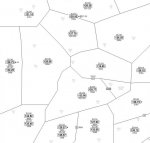I've been scanning a long time, but aircraft monitoring has never been much of a focus. I'm trying to understand the structure. Right now, I just have a jumble of aircraft freqs loaded. A few of my scanners actually have the local RR DB freqs. and some just have all the local hits in the air band. I'm trying to understand the frequency handoffs in relation to the charts. I have SLC TAC, SLC, ENR High03, Low09, etc. I'm also aware (and fascinated by) tracking pages like FlightRadar24, etc.
My first question is where do I find the 'Sectors'? I hear a lot of traffic on freqs from rr db with the Sector 32 or 33 label. I can't find those references on the chart.
Lots more questions, but one thing at a time. I could not find a "Scannist's Guide to Sectional Charts" anywhere.
Thanks
My first question is where do I find the 'Sectors'? I hear a lot of traffic on freqs from rr db with the Sector 32 or 33 label. I can't find those references on the chart.
Lots more questions, but one thing at a time. I could not find a "Scannist's Guide to Sectional Charts" anywhere.
Thanks







